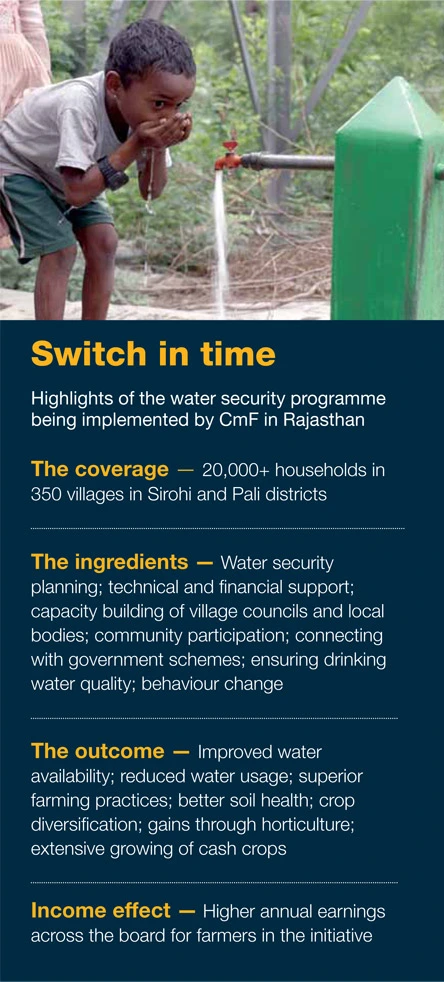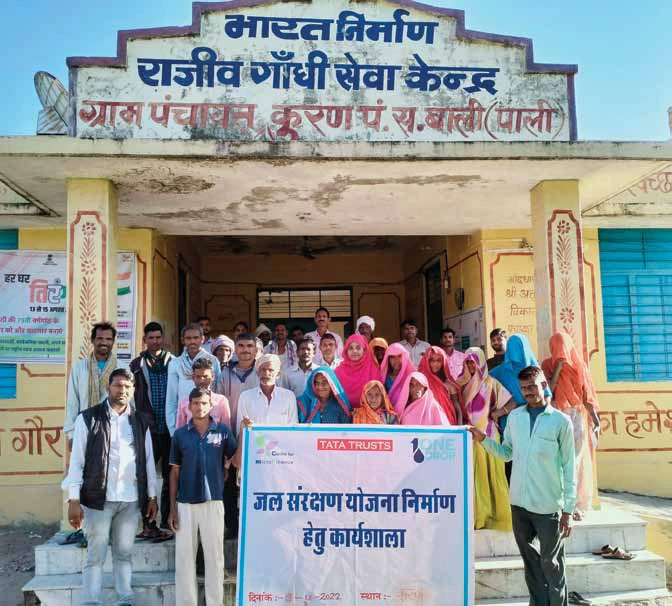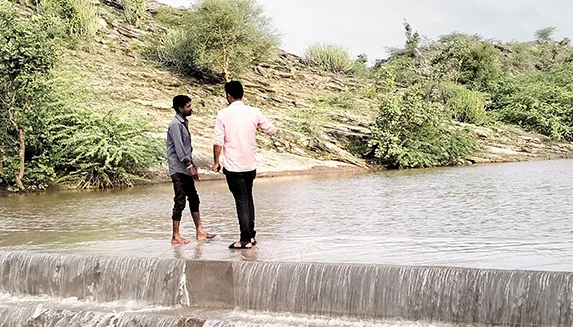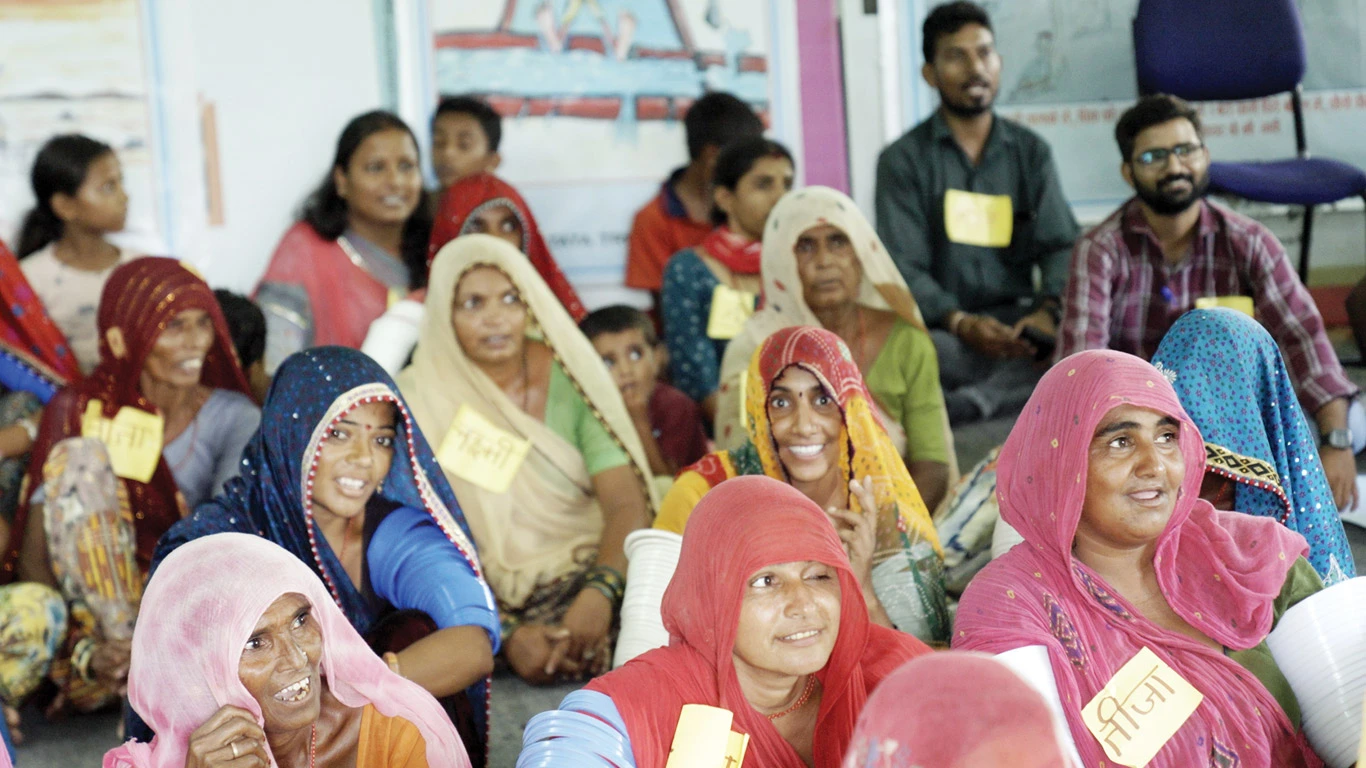Water wisdom fuels a world of change
Water is the most valuable of resources and its optimal use is vital in every way — that’s the learning absorbed in overflowing measure by 20,000-plus households in 350 ‘water-secure’ Rajasthan villages
Think ‘budget’ and what comes to mind are finance ministers, grand pronouncements and endless analyses. Not so for Shaitan Singh Songira, whose understanding of what the word means is of recent vintage, and a bit different from the norm.
A 44-year-old farmer from Kambhal village in Rajasthan’s Sirohi district, Mr Songira sees budget and budgeting in terms of water: how much of it he can access and use, what conditions will ensure its continuing availability, and why being prudent about it now and in the future is best for him, his family and his community.
“We had never heard of a budget, let alone a budget in the context of water,” says Mr Songira. “Then we did a water budgeting exercise and that’s when we realised the situation we were in: we did not have enough water and we were being wasteful with what we had. We were using more than 80% of our water for farming, our water systems were inadequate and inefficient, and the quality of the water was not good enough.”
There is a water committee in Mr Songira’s village now and he is its president. That gives him a better perspective than most on the ebb and flow of the precious liquid. “Where there is water, there is life,” he says. “There are shortcomings in our village but we are on our way to removing them. The more we come together and work as a community, the greater will be our chances of development.”
The change in their approach to water began happening for Mr Songira and his fellow villagers with the implementation of a ‘water security programme’ in Kambhal by Centre for microFinance (CmF), an associate organisation of the Tata Trusts. Launched in April 2022, the initiative has thus far reached more than 20,000 households in 350 villages in Rajasthan’s Sirohi and Pali districts. Designed to be inclusive and sustainable, the CmF initiative is comprehensive and nuanced in method. Community participation is the key and every intervention starts with meetings involving, among others, village elders and influencers. That’s the groundwork leading up to a series of workshops — a ‘water crisis’ game is part of the creative proceedings — that villagers are invited and cajoled to attend.
In the right order
With any given implementation village, the programme unfolds in phases from here on: water security planning; the setting up of a water security committee (WSC); technical and financial support to the WSC; seeding water-augmentation and water-saving systems; capacity building of panchayats (village councils) and local institutions; leveraging government schemes; and ensuring drinking water quality.
The water security plan places strong emphasis on both supply-side interventions (to augment groundwater levels through recharge and harvesting) and demand-side interventions (to enhance water-use efficiency, specifically in agriculture.
All of this adds up to a collective kind of well-being that has eased the daily grind of the farmers in the venture. One of them is Navaram Meghwal, whose weather-beaten face breaks into the slightest of smiles as he remembers a time when growing crops on his 5-acre spread was a struggle. “It used to be hard work and we wasted a lot of water,” says the 51-year-old from Mamavali village in Sirohi.
Mr Meghwal has come a long way since. He cultivates a variety of crops, his annual income has climbed to nearly ![]() 400,000 and he believes there is scope for further improvement. “I have a micro-irrigation setup, I use bio-fertilisers, I have learned about superior farming practices — and I use a lot less water in my field,” he says.
400,000 and he believes there is scope for further improvement. “I have a micro-irrigation setup, I use bio-fertilisers, I have learned about superior farming practices — and I use a lot less water in my field,” he says.
Like many villagers in the areas where the intervention has taken root, Mr Meghwal was reluctant initially to join it. “There’s a natural suspicion of outsiders here and that’s how we saw CmF at first when it came to introduce the initiative,” he adds. “You are always thinking, ‘What are these people selling, what do they want?’ But our doubts soon gave way to trust, simply because CmF demonstrated the efficacy of their procedures and also their sincerity. Their people are very helpful.”
Swaruparam Mali did not need much convincing to become part of the initiative. A 49-year-old government schoolteacher from Varal village in Sirohi, he grows groundnuts and castor on a 15-acre land parcel that he has leased with a partner. “I connected immediately with what CmF was advocating because environment is among the subjects I teach and I keep talking to my schoolchildren about water,” he says. “I had never before seen villagers making a water budget. That was something.”

Meticulous method
From preparations to operations, the CmF team has been meticulous with its implementation of the water security programme. The detailing tells the story: workshop planning, data collection, field visits for villagers, monitoring fluoride levels in the water, water security processes, supply- and demand-side measures, provisioning of funds and, not least, aligning with the state government and its schemes.
Expending an overload of energy on tasks big and small has reaped dividends but, as with any extensive and intensive social development endeavour, there’s always more to be done.
“The first big challenge is getting farmers to shift from their traditional practices; we cannot do this overnight,” says Parikshit Singh Tomar, lead, behaviour change communication, CmF. “For example, with wheat it suffices to water the crop five-six times in its growth cycle. But farmers water their wheat endlessly and unnecessarily. We have created a model to counter this, one that can be easily replicated.”
The good news is that farmers, once shown the rights and wrongs, are willing to adapt. “The mindset change is vital and it goes beyond water,” adds Mr Tomar. “There’s fertiliser use, soil health, farming practices, crop diversification, community participation and plenty more. It begins with water and then everything happens together. Within the given framework, we have a mix-and-match approach.”
“The results are starting to show,” says Ganpat Singh Kumpawat, CmF’s team lead for the programme. “We have a pool of model farmers and model villages and the time is ripe to make this pool bigger by adding more farmers and more youth to it. And we want to craft multiple options for our farmers. That’s the goal.”
CmF has a bunch of partners backing its water cause in Rajasthan, among them the Canada-based One Drop Foundation and the Crompton CSR Foundation. Also pitching in with support are arms of the state and central governments, particularly with training villagers in water security.
Government for partner
The Rajasthan government has gone out of its way to collaborate with and enable CmF in tackling what is a clear and present crisis. “Groundwater levels are falling drastically in the state; where once you could find water at 25-30 feet, today you have to go down 150 feet or more,” says Bhagwat Singh Deora, an assistant agricultural officer with the state government.
“Making matters worse is erratic rainfall; sometimes very little of it and sometimes too much of it, and in short spells,” adds Mr Deora. “Of course, we need all the help we can get and organisations like the Tata Trusts provide that. What’s certain is that we cannot keep going the way we have been. Water conservation is crucial in the context.”

Mr Deora bemoans the mentality of farmers who are stuck in their ways, blaming it partly on low education levels in Sirohi and its neighbouring districts. “Many farmers are just not aware of how deep the problem runs, but the government understands. We have different schemes in place and we are promoting micro- and mini-irrigation projects, crops that require less water, and horticulture.”
[One government initiative that stands out in Rajasthan is ‘drone didi’. Elder sister is what didi translates into and these are women trained to pilot drones that can be employed to do land surveys and spray pesticides in village fields, a chore that farmers are only too glad to outsource.]
The pessimism that envelops agriculture and its future in India may have some justification, but not as far as Hemraj Meena is concerned. A deputy director with the state government’s horticulture department, Mr Meena believes the outlook for farming is brighter than at any time in the recent past.
“In Rajasthan at least, we have witnessed a return to farming from when the Covid pandemic struck, especially with regard to migrants who were forced to return home,” he says. “The government is delivering a lot of support for free and there are many farmers — the educated among them, for sure — who run their show like a proper business. I don’t think it’s true that no farmer wants his children in agriculture.”
Mr Meena understands the importance of organisations like the Tata Trusts, their nimbleness and their ability to quicken the pace of social and community development. “The government cannot cover every sector and then there are all these rules and formalities, red tape and bureaucracy,” he adds. “That’s eliminated when an efficient and genuine outside agency comes into the picture.”
Help from the outside has worked out fine for Leelaram Meghwal, a 52-year-old widower who also hails from Varal in Sirohi. He owns 18 acres of land and his farm income has jumped from ![]() 250,000 annually to
250,000 annually to ![]() 750,000 since joining the water security initiative. “I did what the CmF people told me to and there has been no looking back,” he says.
750,000 since joining the water security initiative. “I did what the CmF people told me to and there has been no looking back,” he says.

